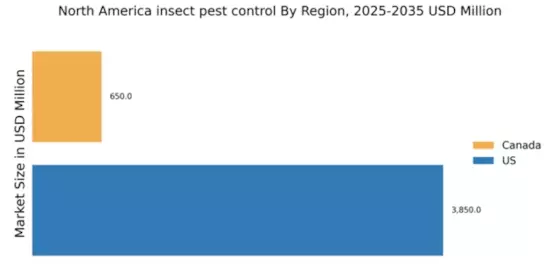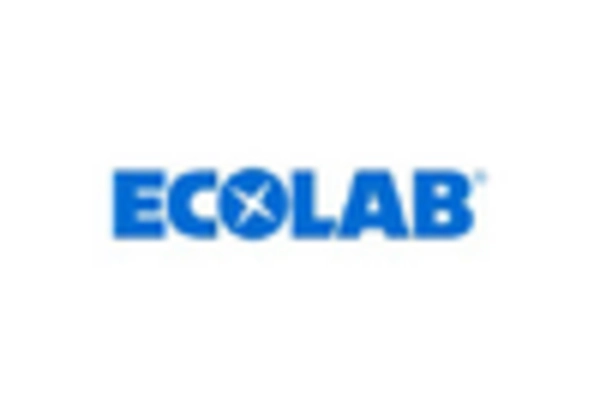Increased Awareness of Health Risks
Growing awareness of the health risks associated with pest infestations is significantly influencing the insect pest-control market. Pests such as mosquitoes and ticks are known carriers of diseases like West Nile virus and Lyme disease, which pose serious health threats to the population. As public health campaigns emphasize the importance of pest management, consumers are more inclined to invest in pest-control services. Recent surveys indicate that nearly 70% of households in North America consider pest control a priority for health and safety. This heightened awareness is prompting both residential and commercial sectors to seek professional pest management solutions, thereby expanding the market. The insect pest-control market is likely to benefit from this trend as it aligns with the growing demand for health-conscious pest management practices.
Rising Urbanization and Population Density
The increasing urbanization in North America is driving the insect pest-control market. As more people migrate to urban areas, the demand for effective pest management solutions escalates. Urban environments provide ideal breeding grounds for various pests, including rodents and insects. Consequently, pest-control services are becoming essential for maintaining public health and safety. According to recent data, urban areas in North America have seen a population growth of approximately 10% over the last decade, leading to a corresponding rise in pest-related issues. This trend necessitates innovative pest-control strategies to address the unique challenges posed by densely populated regions. The insect pest-control market must adapt to these changing dynamics, focusing on targeted solutions that cater to urban settings.
Technological Innovations in Pest Management
Technological advancements are reshaping the insect pest-control market, offering new tools and methods for effective pest management. Innovations such as smart traps, drones for monitoring infestations, and data analytics for predictive pest control are gaining traction. These technologies enhance the efficiency and effectiveness of pest management strategies, allowing for targeted interventions. For example, the use of IoT devices enables real-time monitoring of pest activity, leading to timely responses. The market for pest control technology is projected to grow at a CAGR of 8% over the next five years, reflecting the increasing reliance on technology in pest management. As these innovations become more accessible, the insect pest-control market is poised for significant transformation, catering to the evolving needs of consumers.
Regulatory Changes and Compliance Requirements
The insect pest-control market is experiencing shifts due to evolving regulatory frameworks and compliance requirements. Government agencies are increasingly implementing stringent regulations regarding pesticide usage and environmental safety. These regulations aim to protect public health and the ecosystem, thereby influencing pest-control practices. Companies in the industry must adapt to these changes by adopting safer, more sustainable pest management solutions. For instance, the Environmental Protection Agency (EPA) has introduced new guidelines that require pest-control operators to utilize integrated pest management (IPM) techniques. This shift not only ensures compliance but also enhances the industry's reputation. As a result, the insect pest-control market is likely to see a rise in demand for eco-friendly products and services that meet regulatory standards.
Climate Change and Its Impact on Pest Populations
Climate change is emerging as a critical driver affecting the insect pest-control market. Alterations in temperature and precipitation patterns are influencing pest populations and their distribution. Warmer temperatures can lead to increased pest activity and extended breeding seasons, resulting in higher infestation rates. For instance, studies indicate that certain pest species are expanding their range northward due to milder winters. This shift necessitates adaptive pest management strategies to address the changing dynamics of pest populations. The insect pest-control market must remain vigilant and responsive to these environmental changes, potentially leading to increased demand for pest control services. As climate-related challenges continue to evolve, the industry is likely to experience growth opportunities in developing innovative solutions to combat emerging pest threats.


















Leave a Comment